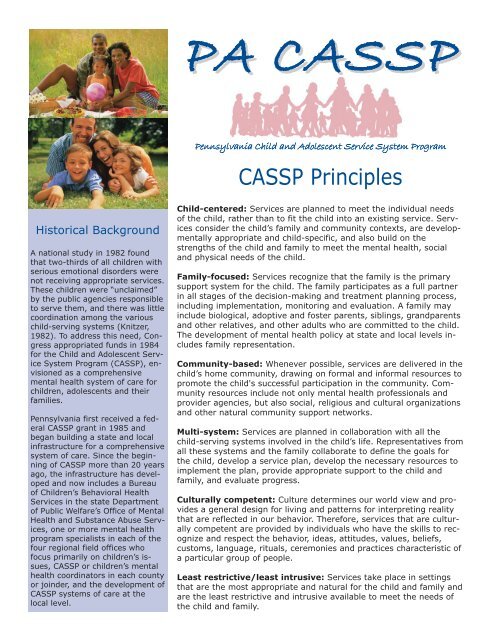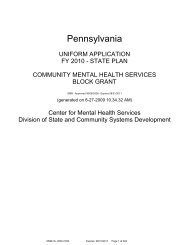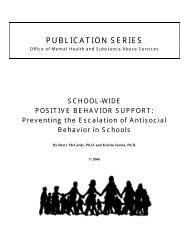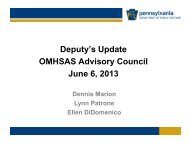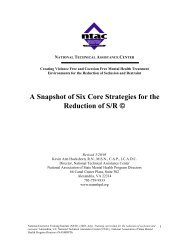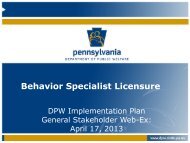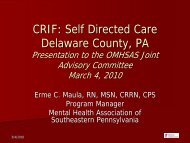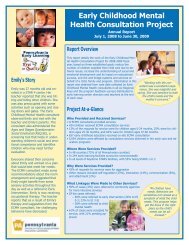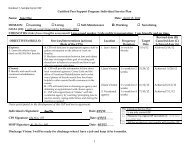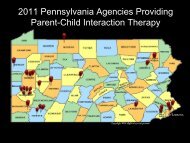Pa cassp - Pennsylvania Recovery and Resiliency
Pa cassp - Pennsylvania Recovery and Resiliency
Pa cassp - Pennsylvania Recovery and Resiliency
Create successful ePaper yourself
Turn your PDF publications into a flip-book with our unique Google optimized e-Paper software.
PA CASSP<br />
<strong>Pennsylvania</strong> Child <strong>and</strong> Adolescent Service System Program<br />
CASSP Principles<br />
Historical Background<br />
A national study in 1982 found<br />
that two-thirds of all children with<br />
serious emotional disorders were<br />
not receiving appropriate services.<br />
These children were “unclaimed”<br />
by the public agencies responsible<br />
to serve them, <strong>and</strong> there was little<br />
coordination among the various<br />
child-serving systems (Knitzer,<br />
1982). To address this need, Congress<br />
appropriated funds in 1984<br />
for the Child <strong>and</strong> Adolescent Service<br />
System Program (CASSP), envisioned<br />
as a comprehensive<br />
mental health system of care for<br />
children, adolescents <strong>and</strong> their<br />
families.<br />
<strong>Pennsylvania</strong> first received a federal<br />
CASSP grant in 1985 <strong>and</strong><br />
began building a state <strong>and</strong> local<br />
infrastructure for a comprehensive<br />
system of care. Since the beginning<br />
of CASSP more than 20 years<br />
ago, the infrastructure has developed<br />
<strong>and</strong> now includes a Bureau<br />
of Children’s Behavioral Health<br />
Services in the state Department<br />
of Public Welfare’s Office of Mental<br />
Health <strong>and</strong> Substance Abuse Services,<br />
one or more mental health<br />
program specialists in each of the<br />
four regional field offices who<br />
focus primarily on children’s issues,<br />
CASSP or children’s mental<br />
health coordinators in each county<br />
or joinder, <strong>and</strong> the development of<br />
CASSP systems of care at the<br />
local level.<br />
Child-centered: Services are planned to meet the individual needs<br />
of the child, rather than to fit the child into an existing service. Services<br />
consider the child’s family <strong>and</strong> community contexts, are developmentally<br />
appropriate <strong>and</strong> child-specific, <strong>and</strong> also build on the<br />
strengths of the child <strong>and</strong> family to meet the mental health, social<br />
<strong>and</strong> physical needs of the child.<br />
Family-focused: Services recognize that the family is the primary<br />
support system for the child. The family participates as a full partner<br />
in all stages of the decision-making <strong>and</strong> treatment planning process,<br />
including implementation, monitoring <strong>and</strong> evaluation. A family may<br />
include biological, adoptive <strong>and</strong> foster parents, siblings, gr<strong>and</strong>parents<br />
<strong>and</strong> other relatives, <strong>and</strong> other adults who are committed to the child.<br />
The development of mental health policy at state <strong>and</strong> local levels includes<br />
family representation.<br />
Community-based: Whenever possible, services are delivered in the<br />
child’s home community, drawing on formal <strong>and</strong> informal resources to<br />
promote the child's successful participation in the community. Community<br />
resources include not only mental health professionals <strong>and</strong><br />
provider agencies, but also social, religious <strong>and</strong> cultural organizations<br />
<strong>and</strong> other natural community support networks.<br />
Multi-system: Services are planned in collaboration with all the<br />
child-serving systems involved in the child’s life. Representatives from<br />
all these systems <strong>and</strong> the family collaborate to define the goals for<br />
the child, develop a service plan, develop the necessary resources to<br />
implement the plan, provide appropriate support to the child <strong>and</strong><br />
family, <strong>and</strong> evaluate progress.<br />
Culturally competent: Culture determines our world view <strong>and</strong> provides<br />
a general design for living <strong>and</strong> patterns for interpreting reality<br />
that are reflected in our behavior. Therefore, services that are culturally<br />
competent are provided by individuals who have the skills to recognize<br />
<strong>and</strong> respect the behavior, ideas, attitudes, values, beliefs,<br />
customs, language, rituals, ceremonies <strong>and</strong> practices characteristic of<br />
a particular group of people.<br />
Least restrictive/least intrusive: Services take place in settings<br />
that are the most appropriate <strong>and</strong> natural for the child <strong>and</strong> family <strong>and</strong><br />
are the least restrictive <strong>and</strong> intrusive available to meet the needs of<br />
the child <strong>and</strong> family.
PA CASSP<br />
State <strong>and</strong> Local <strong>Pa</strong>rtnerships<br />
For more than 20 years, the children’s behavioral<br />
health system in <strong>Pennsylvania</strong> has been guided<br />
by the CASSP philosophy. The acronym CASSP<br />
refers to the Child <strong>and</strong> Adolescent Service System<br />
Program, a comprehensive system of care for children<br />
<strong>and</strong> adolescents with serious emotional disorders<br />
<strong>and</strong> their families. The system of care<br />
approach, foundational to CASSP, ensures that<br />
services <strong>and</strong> treatment for children <strong>and</strong> adolescents<br />
with or at risk of serious emotional disorders are<br />
planned collaboratively with the family <strong>and</strong> all<br />
agencies involved in the child’s or adolescent’s life.<br />
<strong>Pa</strong>rtnerships are critical to the success of any system<br />
of care.<br />
A comprehensive <strong>and</strong> effective system of care<br />
recognizes that children <strong>and</strong> adolescents with serious<br />
emotional <strong>and</strong> behavioral needs often require<br />
services from more than one child-serving system.<br />
For example, a child with a behavioral health need<br />
is usually in school, <strong>and</strong> may also be receiving services<br />
from the child welfare, juvenile justice, or<br />
health care system due to emotional, social or<br />
physical needs, in addition to being part of a family.<br />
Planning takes into account the strengths of the<br />
child <strong>and</strong> family <strong>and</strong> these multiple needs, <strong>and</strong> involves<br />
different agencies.<br />
At the state level, departments <strong>and</strong> agencies<br />
with programs serving children collaborate on children’s<br />
issues. These include program offices in the<br />
Department of Public Welfare (Office of Child Development<br />
<strong>and</strong> Early Learning; Office of Children,<br />
Cross-Systems Initiatives<br />
• Alternatives to Coercive Techniques (restraint-free initiative)<br />
• Early Childhood Mental Health Consultation<br />
• Fetal Alcohol Spectrum Disorder Task Force<br />
• Integrated Children’s Services Planning<br />
• Juvenile Firesetter Intervention<br />
• Behavioral Health Needs of Children <strong>and</strong> Adolescents in<br />
the Juvenile Justice System<br />
Youth <strong>and</strong> Families; Office of Development Programs;<br />
<strong>and</strong> Office of Mental Health <strong>and</strong> Substance<br />
Abuse Services), the Juvenile Court Judges’ Commission,<br />
the Office of Health Promotion <strong>and</strong> Disease<br />
Prevention in the Department of Health (maternal<br />
<strong>and</strong> child health, drug <strong>and</strong> alcohol programs), the<br />
Office of Elementary <strong>and</strong> Secondary Education in<br />
the Department of Education, <strong>and</strong> the Bureau of<br />
Vocational Rehabilitation in the Department of<br />
Labor <strong>and</strong> Industry. (See below for a partial list of<br />
cross-systems initiatives.) The Children’s Subcommittee<br />
of the OMHSAS Advisory Committee brings<br />
together family members, advocates <strong>and</strong> professionals<br />
from behavioral health <strong>and</strong> the other childserving<br />
systems to provide input into state policy<br />
<strong>and</strong> program development. A Youth Advisory Subcommittee,<br />
consisting of youth who have been<br />
served by the behavioral health system, also provides<br />
regular input.<br />
At the county level, integrated children’s services<br />
planning is required by the Department of Public<br />
Welfare. Each county or joinder has at least one<br />
person identified as a CASSP or children’s behavioral<br />
health coordinator who serves as the county<br />
contact person for children with multi-system<br />
needs; these coordinators are resourced in part by<br />
their regional children’s teams consisting of designated<br />
individuals in the OMHSAS Field Offices<br />
(Pittsburgh, Harrisburg, Scranton <strong>and</strong> Norristown).<br />
Many counties also have local CASSP or children’s<br />
advisory committees.<br />
• Services for Deaf <strong>and</strong> Hard-of-Hearing Children with<br />
Behavioral Health Needs<br />
• School-Based Behavioral Health<br />
• St<strong>and</strong>ards for <strong>and</strong> Alternatives to Residential Treatment<br />
Facilities<br />
• Student Assistance Program<br />
• System of Care Initiative<br />
• Transition Planning <strong>and</strong> Services<br />
• Youth Suicide Prevention
PA CASSP<br />
<strong>Pennsylvania</strong> Array of Services<br />
The current array of behavioral health services (mental health <strong>and</strong> drug <strong>and</strong><br />
alcohol) for children <strong>and</strong> adolescents includes the following, generally listed<br />
in order from least restrictive to most restrictive:<br />
• Case management services, including intensive case management <strong>and</strong> resource<br />
coordination<br />
• Outpatient therapy<br />
• Intensive outpatient (drug <strong>and</strong> alcohol)<br />
• School-based behavioral health services<br />
• Behavioral health rehabilitation services (behavioral specialist consultant,<br />
mobile therapy, <strong>and</strong> therapeutic staff support; summer therapeutic staff<br />
support; individualized program exception services; <strong>and</strong> evidence-based<br />
services such as multisystemic therapy <strong>and</strong> functional family therapy)<br />
• <strong>Pa</strong>rtial hospitalization services<br />
• Family-Based Mental Health Services<br />
• Community residential rehabilitation services<br />
• Residential treatment facilities (some also provide various drug <strong>and</strong> alcohol<br />
services based on licensure)<br />
• Non-hospital residential (drug <strong>and</strong> alcohol detox, rehabilitation, halfway<br />
house)<br />
• Inpatient hospitalization (mental health, also drug <strong>and</strong> alcohol detox or rehabilitation<br />
based on medical necessity)<br />
The following services are also available:<br />
• Prevention/intervention services (drug <strong>and</strong> alcohol)<br />
• Crisis intervention <strong>and</strong> emergency services<br />
• Early intervention<br />
• Early childhood mental health consultation<br />
• Family support services<br />
• School-to-work transition services<br />
Youth <strong>and</strong> Family Teams<br />
Across the nation, there is growing recognition of the need to use evidence-based practices to address the<br />
challenges of children <strong>and</strong> youth with serious behavioral health problems. Services such as multisystemic<br />
therapy, functional family therapy, <strong>and</strong> multidimensional treatment foster care have an impressive research<br />
base.<br />
While these interventions come with strong empirical support, there is emerging evidence that Youth <strong>and</strong><br />
Family Teams, with their emphasis on family engagement, can further improve outcomes of evidence<br />
based practices. Youth <strong>and</strong> Family Teams engender commitment to evidence-based practices by engaging<br />
youth <strong>and</strong> families in choosing the most effective treatment.<br />
In <strong>Pennsylvania</strong>, we are changing the practice model to establish Youth <strong>and</strong> Family Teams as the center of<br />
service planning <strong>and</strong> delivery. A Youth <strong>and</strong> Family Institute has recently been created, funded by the Department<br />
of Public Welfare <strong>and</strong> operated by the University of Pittsburgh, to train, coach, <strong>and</strong> monitor the<br />
facilitation of Youth <strong>and</strong> Family Teams. Training will be based on the st<strong>and</strong>ards recently established by the<br />
National Wraparound Initiative. In addition, in light of strong evidence that adherence to the principles <strong>and</strong><br />
protocols of the wraparound process predicts future child <strong>and</strong> family service <strong>and</strong> functioning outcomes, a<br />
fidelity monitoring tool will be used to monitor <strong>and</strong> support quality. This will insure adherence to best practice<br />
for youth <strong>and</strong> their families.
PA CASSP<br />
Selected Resources in Children's Behavioral<br />
Health <strong>and</strong> Systems of Care<br />
<strong>Pennsylvania</strong><br />
Alert, a monthly administrative update; The PA CASSP Newsletter, a quarterly publication on children’s behavioral<br />
health. Both published by the Office of Mental Health <strong>and</strong> Substance Abuse Services.<br />
Child, Family <strong>and</strong> Community Core Competencies, originally published by the former PA CASSP Training<br />
<strong>and</strong> Technical Assistance Institute, 1999.<br />
Guidelines for Best Practice in Children’s Mental Health Services, by Gordon R. Hodas, M.D., Office of Mental<br />
Health <strong>and</strong> Substance Abuse Services, 2001.<br />
Performance Expectations <strong>and</strong> Recommended Guidelines for County CASSP Systems, Office of Mental<br />
Health <strong>and</strong> Substance Abuse Services Bulletin, 2002.<br />
National<br />
National Mental Health Information Center: http://mentalhealth.samhsa.gov<br />
National Technical Assistance Center for Children’s Mental Health<br />
Center for Child <strong>and</strong> Human Development, Georgetown University<br />
Box 571485, Washington, DC 20057<br />
Phone: 202-687-5000; Web site: http://gucdc.georgetown.edu<br />
National Wraparound Initiative: http://www.rtc.pdx.edu/nwi/<br />
Research <strong>and</strong> Training Center for Children’s Mental Health<br />
Florida Mental Health Institute, University of South Florida<br />
13301 Bruce B. Downs Blvd., Tampa, FL 33162<br />
Phone: 813-974-4661; Web site: http://rtckids.fmhi.usf.edu/<br />
Research <strong>and</strong> Training Center on Family Support <strong>and</strong> Children’s Mental Health<br />
Portl<strong>and</strong> State University<br />
P. O. Box 751, Portl<strong>and</strong>, OR 92707<br />
Phone: 503-725-4040; Web site: www.rtc.pdx.edu<br />
Substance Abuse <strong>and</strong> Mental Health Services Administration (SAMHSA): www.samhsa.gov<br />
For More CASSP or Children’s Behavioral Health Information<br />
Contact your county Mental Health/Mental Retardation or Human Services office, or<br />
Department of Public Welfare<br />
Office of Mental Health <strong>and</strong> Substance Abuse Services<br />
Bureau of Children’s Behavioral Health Services<br />
DGS Annex Complex, Beechmont Building, P. O. Box 2675, Harrisburg, PA 17105<br />
Phone: 717-772-7984; Fax: 717-705-8268; Web site: www.dpw.state.pa.us


